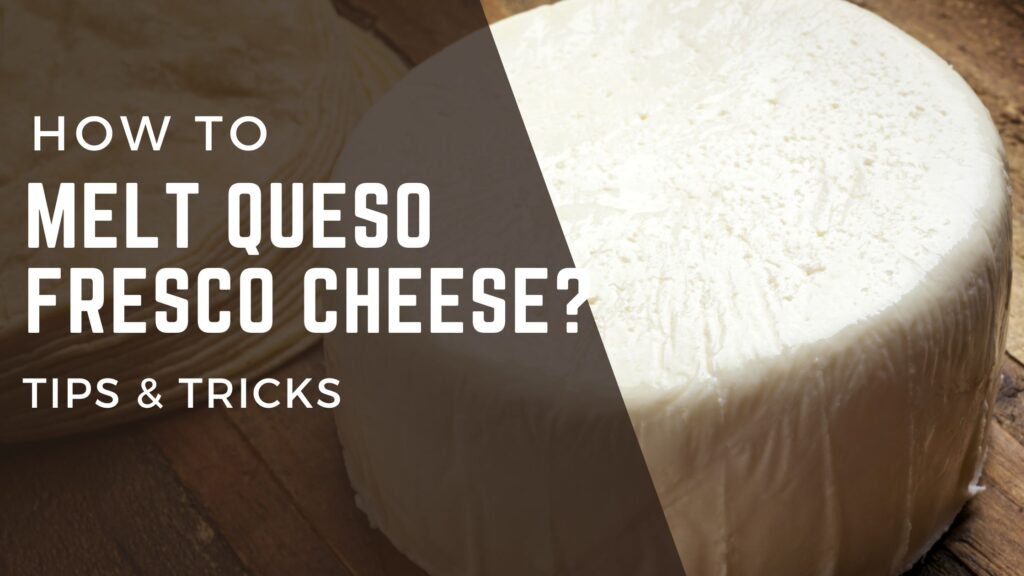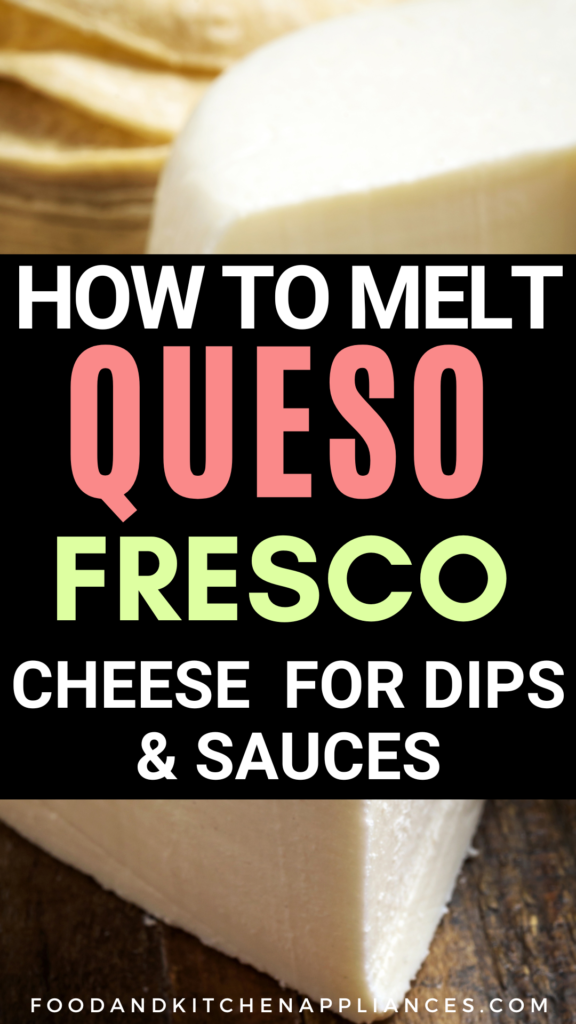Are you a fan of Queso Fresco? This crumbly and salty cheese is a staple in many Mexican dishes, but have you ever tried melting it? While Queso Fresco is not known for its melting abilities, turning it into a smooth and creamy sauce or dip is possible. This article will explore different methods for melting Queso Fresco to help you achieve the perfect texture for your favorite recipes.

Can you melt Queso Fresco cheese?
The answer is yes, you can melt the queso fresco. This cheese is not known for its melting properties and is difficult to melt. Unlike other types of cheese, Queso Fresco does not melt quickly and can become grainy or lumpy if not handled correctly.
However, with the proper technique and simple ingredients, you can transform this cheese into a delicious and versatile sauce that will elevate your dishes to the next level.
What is Queso Fresco?
Queso Fresco is a type of fresh cheese that originated in Mexico. It is a soft, crumbly cheese made from cow’s milk or a combination of cow’s and goat’s milk. The cheese has a slightly tangy flavor and a creamy texture, making it a popular choice for many Mexican dishes.
It is commonly used as a topping for tacos, enchiladas, and other Mexican dishes. It can also be crumbled and used as a filling for chiles rellenos, quesadillas, and burritos.
One of the unique characteristics of Queso Fresco is that it does not melt quickly. While it can be melted over low heat to make a cheesy dip or sauce, it may remain chunky.
Why Melt Queso Fresco?
While queso fresco is delicious, melting it can take your dishes to the next level. Here are a few reasons why you might want to melt queso fresco:
Enhance the Creaminess
Melted queso fresco has a creamy texture that can add a luxurious feel to your dishes. Whether making a cheesy dip or topping your favorite dish with melted queso fresco, it can add a silky mouthfeel that’s hard to resist.
Create a Thicker Sauce
Queso fresco doesn’t melt as quickly as other cheeses, which makes it perfect for creating a thicker sauce. It can create a smooth, velvety sauce perfect for dipping or drizzling your favorite dishes when melted.
Add a New Dimension of Flavor
When queso fresco is melted, its flavor intensifies, becoming nutty and slightly tangy. This can add a new dimension of flavor to your dishes, making them more complex and exciting.
Make it Easier to Incorporate
If you’re using queso fresco as a filling, melting it can make it easier to incorporate into your dish. Whether stuffing peppers or making a quesadilla, melted queso fresco can mix more easily with other ingredients, creating a more cohesive filling.
Methods for Melting Queso Fresco
When it comes to melting Queso Fresco, you can use two main methods: the microwave method and the stovetop method. Each method has advantages and disadvantages, so it’s up to you to decide which works best for you.
Microwave Method
The microwave method is the quickest and easiest way to melt Queso Fresco. Here’s how to do it:
- Shred or grate the Queso Fresco and place it in a microwave-safe bowl.
- Microwave the cheese on medium heat for 10-15 seconds, stirring in between, until it reaches an even consistency.
- Be careful not to overheat the cheese, as it can become rubbery and lose its flavor.
One downside to the microwave method is that the cheese can sometimes become too liquid or grainy. To avoid this, add a small amount of milk or cream to the cheese before microwaving it.
Stovetop Method
The stovetop method takes longer than the microwave method but can produce a creamier and more flavorful melted cheese. Here’s how to do it:
- Shred or grate the Queso Fresco and place it in a saucepan.
- Add a small amount of milk or cream to the cheese and heat it over low heat.
- Stir the cheese constantly until it melts and becomes creamy.
- Be careful not to overheat the cheese, as it can become rubbery and lose its flavor.
One advantage of the stovetop method is adding other ingredients to the cheese, such as salsa or spices, to enhance its flavor. However, this method requires more time and attention than the microwave method.
Tips for Melting Queso Fresco
When it comes to melting queso fresco, a few tips can help ensure success. Here are some things to keep in mind:
Choosing the Right Queso Fresco
Not all queso fresco is created equal when it comes to melting. Look for a softer, fresher queso fresco sold in a block or crumbled. Avoid aged or complex queso fresco, which won’t melt as well. You can also try mixing queso fresco with another cheese that melts well, such as Monterey Jack or cheddar.
Stirring Constantly
Queso fresco can be prone to clumping when melted, so it’s important to stir it constantly to ensure a smooth, even melt. Use a whisk or spatula to stir the cheese as it melts. If the cheese is too thick, add a small amount of milk or cream to thin it out and make it easier to stir.
To melt queso fresco, you can use a stovetop or microwave method. For stovetop melting, add the cheese to a saucepan and heat over low heat, stirring constantly with a whisk until melted. For microwave melting, microwave the cheese in 30-second intervals, stirring in between, until melted.
Overall, melting queso fresco can be tricky. Still, with the proper techniques and patience, you can achieve a smooth, creamy melt perfect for dipping, topping, or adding to your favorite recipes.

How to Melt Queso Fresco with Milk
Melted Queso Fresco can add a creamy and delicious flavor to many dishes, such as tacos, nachos, and soups. Here is how you can melt Queso Fresco with milk:
- Grate the Queso Fresco into small pieces or shred it.
- Pour some evaporated milk into a pan and heat it until it boils. Be careful not to burn the milk.
- Add the Queso Fresco into the evaporated milk in small amounts while whisking continuously until the mixture boils.
- Keep adding small amounts of Queso Fresco until you achieve the desired consistency.
- Whisk the mixture until it becomes smooth and runny.
It is essential to keep an eye on the milk while heating it to avoid burning it. Scrap the surfaces of the pot to prevent the evaporated milk and Queso Fresco from sticking to the bottom. The amount of Queso Fresco you add to the evaporated milk depends on how much-melted cheese you want to achieve.
Why is my queso cheese not melting?
If you’ve ever tried to melt queso fresco cheese, you may have noticed that it doesn’t melt like other cheeses. This is because queso fresco is a fresh cheese not meant to melt like other cheeses. Here are a few reasons why your queso cheese may not be melting:
- Queso fresco is a fresh cheese that has a high moisture content. This high moisture content makes it difficult for the cheese to melt.
- Queso fresco is a crumbly cheese that is not designed to melt. When heated, the cheese will soften but not melt like other cheeses.
- Queso fresco is made with acid, which causes the cheese’s proteins to tighten. When heated, the proteins in the cheese become even tighter, making it difficult for the cheese to melt.
- If you are trying to melt queso fresco in a sauce or dip, you may need to add other ingredients to help the cheese soften. For example, add a small amount of cream or milk to the cheese to help it melt.
- If you are trying to melt queso fresco on top of a dish, you may need to preheat the cheese before adding it. This will help the cheese melt more evenly.
Can You Melt Queso Fresco with Crumbling Cheese?
If you’re wondering whether you can melt queso fresco by crumbling cheese, the answer is yes, you can. However, it’s important to note that queso fresco is not a cheese that melts quickly. It has a crumbly texture and a low melting point, which means it can quickly burn or turn into a rubbery mess if not handled correctly.
You must follow simple steps to melt queso fresco by crumbling cheese. First, crumble the cheese or shred it into small pieces. Then, add some evaporated milk into a pan and heat it on low until it boils. Be sure to boil it low to prevent the burning of the milk.
Next, add the crumbled cheese to the evaporated milk in small amounts. Whisk the mixture as it boils until you achieve a runny blend. This will help the cheese melt evenly and prevent it from clumping together.
Once the cheese has melted, you can use it as a dip or a sauce. It’s important to note that the consistency of the melted queso fresco will be runny and not thick like other melted cheeses.
How to Melt Queso Fresco into Dip
To make a delicious and creamy dip with Queso Fresco, you must know how to melt it properly. Here are the steps you need to follow to melt Queso Fresco into dip:
- Grate or shred the Queso Fresco. This will help it melt faster and more evenly.
- Heat a non-stick pan over low heat. Add oil or butter to the pan to prevent the cheese from sticking.
- Add the grated Queso Fresco to the pan in small batches. Whisk the cheese continuously until it melts and turns into a smooth and creamy mixture.
- If the cheese starts to clump or become lumpy, add a small amount of milk or cream to the pan and continue whisking until the cheese melts and becomes smooth again.
- Once the cheese has melted completely, add your favorite ingredients to make a flavorful dip. Some popular additions include chopped tomatoes, onions, jalapenos, and cilantro.
With these simple steps, you can quickly melt Queso Fresco into a delicious and creamy dip that will be a hit at any party or gathering.

Does Queso Fresco Melt in the Oven?
If you’re wondering whether Queso Fresco can be melted in the oven, the answer is yes, but with some considerations. Queso Fresco is not a melting cheese, so it won’t melt as smoothly as other cheeses. However, it can be melted in the oven to create a delicious cheesy dish topping.
To melt Queso Fresco in the oven, preheat the oven to 350°F. Then, place the cheese in an oven-safe dish and bake it for about 10-15 minutes or until it starts to melt. Keep an eye on it to avoid burning it. Once melted, you can use it as a topping for your favorite dishes or dip.
It’s important to note that Queso Fresco may not melt as smoothly as other cheeses and may become grainy or lumpy. To avoid this, mix it with another cheese that melts well, like Monterey Jack or cheddar, to create a smoother texture.
Another option is to turn Queso Fresco into a sauce or dip by adding some liquid, like milk or evaporated milk, to thin it out. This will make it easier to melt and create a smoother texture.
If you don’t have Queso fresco, you can use these substitutes.
How to cook red lentils?